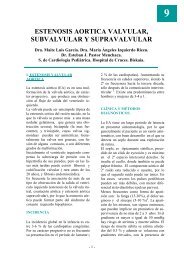Guidelines and Standards for Performance of a Pediatric ...
Guidelines and Standards for Performance of a Pediatric ...
Guidelines and Standards for Performance of a Pediatric ...
You also want an ePaper? Increase the reach of your titles
YUMPU automatically turns print PDFs into web optimized ePapers that Google loves.
Journal <strong>of</strong> the American Society <strong>of</strong> Echocardiography<br />
1422 Lai et al December 2006<br />
Figure 5 Left parasternal long-axis views demonstrated in rightward/inferior to leftward/superior<br />
sweep. 1, Rightward <strong>and</strong> inferior angulation toward right hip shows right atrium (RA), tricuspid valve,<br />
<strong>and</strong> right ventricular (RV) inflow. Coronary sinus can be followed into RA in this view. 2, Parasternal<br />
long-axis view shows left atrium (LA), left ventricle (LV), mitral <strong>and</strong> aortic (Ao) valves, RV, <strong>and</strong> ascending<br />
Ao. 3, Leftward <strong>and</strong> superior angulation toward left shoulder depicts RV outflow tract, pulmonary valve,<br />
<strong>and</strong> main pulmonary artery (PA). (Reproduced with permission from: Geva T. Echocardiography <strong>and</strong><br />
Doppler ultrasound. In: Garson A, Bricker JT, Fisher DJ, Neish SR, editors. The science <strong>and</strong> practice <strong>of</strong><br />
pediatric cardiology. Baltimore: Williams <strong>and</strong> Wilkins; 1997, p. 789-843).<br />
connection <strong>of</strong> the left innominate vein to the<br />
superior vena cava is visualized. The leftward<br />
extent <strong>of</strong> the left innominate vein should be<br />
examined by color flow mapping to exclude a left<br />
superior vena cava or an anomalous pulmonary<br />
venous connection. In smaller individuals, both<br />
the right <strong>and</strong> left pulmonary venous connections<br />
to the left atrium are well visualized in the far field<br />
<strong>of</strong> the suprasternal notch view (crab view). Superior<br />
(cranial) angulation <strong>of</strong> the transducer demonstrates<br />
the branching pattern <strong>of</strong> the aorta. The<br />
sidedness <strong>of</strong> the aortic arch may be determined as<br />
opposite <strong>of</strong> the direction, or sidedness, <strong>of</strong> the first<br />
brachiocephalic artery. A normal branching pattern<br />
<strong>of</strong> the aortic arch should be documented by<br />
demonstration <strong>of</strong> a normally bifurcating first brachiocephalic<br />
artery.<br />
Demonstration <strong>of</strong> the left aortic arch in its long<br />
axis (Figure 8) is achieved by counterclockwise<br />
rotation <strong>of</strong> the transducer from the coronal plane<br />
in the suprasternal notch window. Further counterclockwise<br />
rotation <strong>and</strong> leftward angulation <strong>of</strong>ten<br />
best demonstrates the left pulmonary artery.<br />
Right parasternal views. The rightward extent <strong>of</strong><br />
the atrial septum may be well visualized in a parasagittal<br />
imaging plane from the right parasternal border. 41<br />
Superior (Figure 9) <strong>and</strong> inferior right parasternal windows<br />
may be sought, <strong>and</strong> positioning <strong>of</strong> the patient in<br />
a right lateral decubitus position is <strong>of</strong>ten helpful. From<br />
this view, the atrial septum is oriented perpendicular<br />
to the plane <strong>of</strong> insonation, <strong>and</strong> less dropout artifact is<br />
present. Rotation into a short-axis (transverse) imaging<br />
plane from a superior right parasternal window allows<br />
visualization <strong>and</strong> color flow mapping <strong>of</strong> the right




